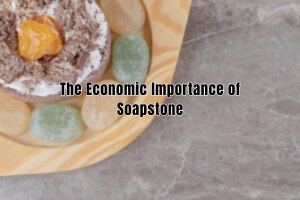The Economic Importance of Soapstone
With its diverse geography and rich natural resources, Pakistan has a wealth of soapstones. These include soapstone, a versatile and valuable material for centuries in many professions and arts. This article explores the importance of talc in Pakistan, its extraction process, uses, and impact on the country’s culture and economy.
Source And Extraction:
Talc, also known as talc, is a metamorphic rock composed primarily of talc and many other minerals such as chlorite, pyroxene, mica, hornblende, and carbonates. In Pakistan, talc deposits are mainly found in the northern mountains, including the Khyber Pakhtunkhwa, Balochistan, and Gilgit-Baltistan regions. These deposits have been mined for centuries, and there is evidence that talc artifacts date back to ancient civilizations such as the Gandhara civilization.
Talc mining in Pakistan generally involves quarries where large blocks of rock are cut from the ground using traditional methods or modern machinery. Once the stone is quarried, it is transported to the office, where it is cut, shaped, and polished to meet various industrial and artistic requirements.
Application:
Talc stone is widely used in industrial and artistic applications due to its unique properties. Its high talc content produces a soft, easy-to-carve material resistant to heat, acids, and electrical conductivity. In an industrial setting, talc makes various products, including countertops, sinks, cookware, electrical insulation, and even automotive components. Its heat resistance makes it ideal for applications where thermal stability is critical, such as wood stoves and laboratory equipment.
Talc has significant cultural and artistic value in Pakistan and industrial uses. Craftsmen and artisans in regions like Taxila and Peshawar have been carving intricate figurines, vases, and decorative items from talc for generations. These pieces often feature fine carvings that reflect the skill and creativity of the artisans and the rich cultural heritage of the region. Pakistan’s wax carvings are valued at home and abroad and contribute to the export of handicrafts from the country.

Cultural Significance:
Soapstone has cultural significance in Pakistan beyond its practical applications. Ancient talc artifacts, including statues of Buddha and other religious figures, have been discovered in the Gandhara region. These artifacts provide insight into ancient civilizations’ artistic and spiritual practices and link to Pakistan’s rich historical past. Additionally, talc carvings are essential to Pakistan’s artistic heritage, with artisans passing their skills down through the generations.
Economic Impact:
The talc industry plays a significant role in Pakistan’s economy and provides employment opportunities to thousands of people nationwide. From miners and quarry workers to artisans and exporters, many individuals are involved in the various stages of the talc supply chain. Additionally, exporting talc products contributes to Pakistan’s foreign exchange earnings and strengthens the economy.
Soapstone is a testament to Pakistan’s rich natural resources and cultural heritage. From its ancient origins to its modern applications, talc plays a vital role in industry and art, shaping the country’s economy and cultural landscape. As Pakistan continues to develop and grow, the importance of talc as a source and symbol of cultural identity remains steadfast.

